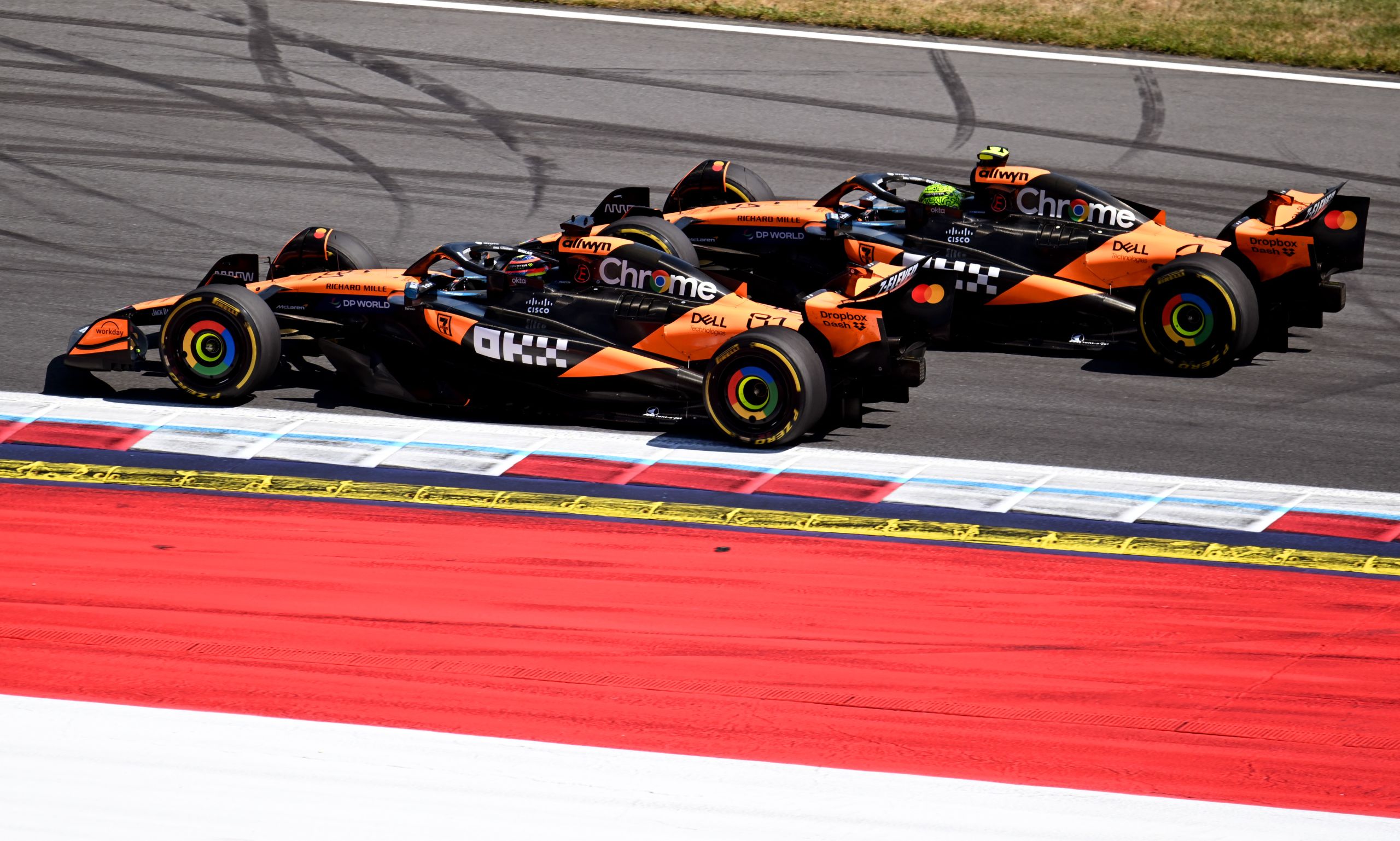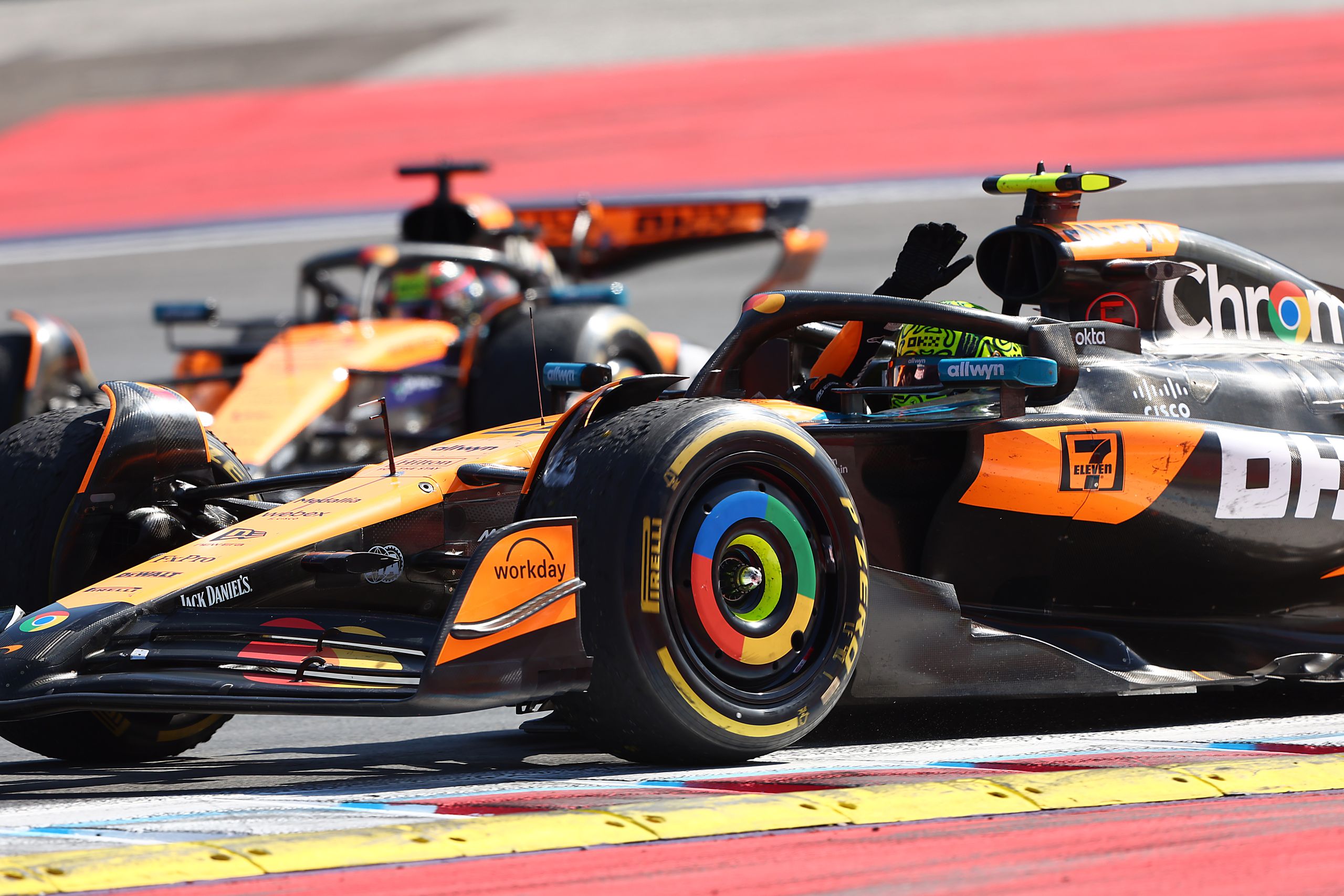Is Formula 1 Boring?
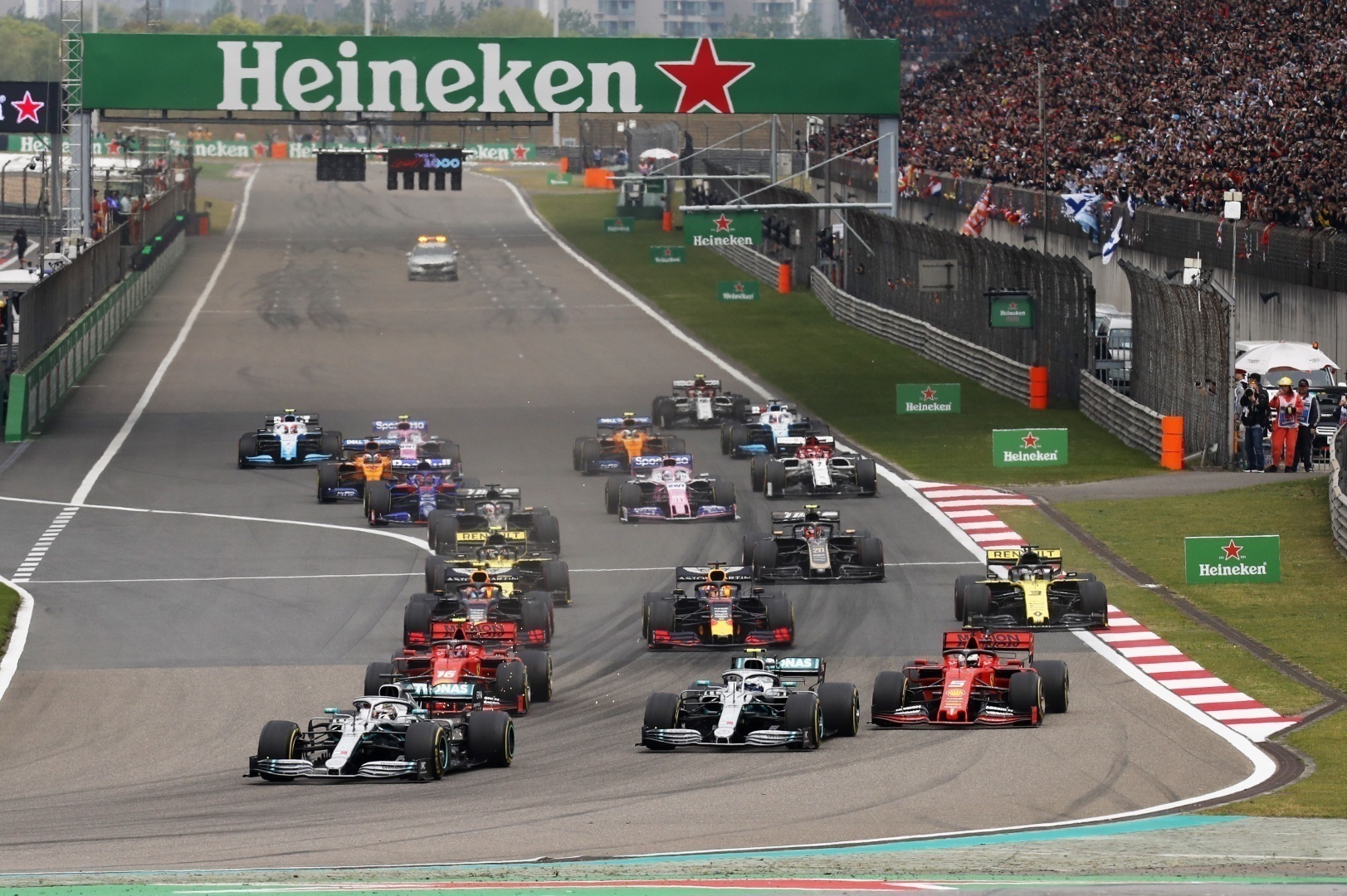
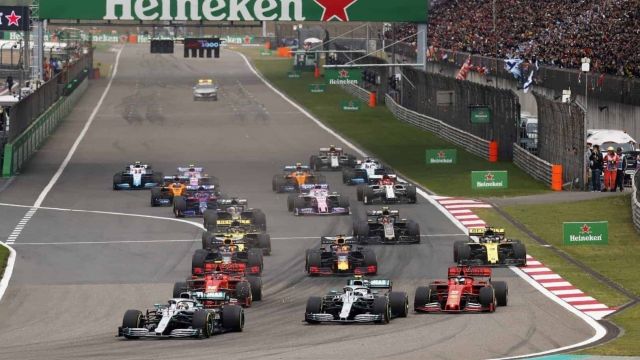
Is Formula 1 boring?
No, of course not!
When I was a child, during the school holidays my younger brother and I would often spend days at our grandparent’s house while our parents were at work. Now the thing about school holidays is you want to be at home playing video games, doing cool shit, not stuck at your grandparents watching re-runs of shows that were bad in the 80s, and are still bad 10, 20, 30 years later.
So we would kick the ball around, play some cricket in the driveway, but invariably we would get bored, and we would go in and complain. ‘Grandma, we’re bored…’
Her response?
‘Boring people get bored.’
Am I calling you boring?
Well maybe I am, but that’s not the point.
The thing about Formula 1, and most sports in general, are the people who are claiming it’s boring are the ones whose favourite driver/athlete/team isn’t winning.
That’s ok, that’s human nature.
In Formula 1, broadly speaking, there are three types of fans.
- The tech-heads who are fascinated with the engineering side of the sport, and accept the periods of domination that come with a team reaching the pinnacle of development.
- The ‘it’s-not-fair’ types who want to punish or handicap the fastest teams so everything is even, like it is in primary school or Communist countries.
- The ‘it was better in my day’ crowd who have re-written history in their memories so all races finished with three cars flying toward the finish line together, casually forgetting that some cars failed to even qualify for the race they were so slow, many finished a lap or two down, if they even finished at all.
Here’s a fun fact: Eyewitnesses are the most unreliable sources of information that we have. This is why police investigators use facts to support cases.
So, we have done a deep dive on the stats provided by Stats F1 over four different periods to compare the facts.
Now given over the years the number of races per season and the number of points given out per race has changed, we have crunched the percentages to see if the current Mercedes-domination is an anomaly, or something cyclical that we have seen over the years, and will see again.
So, is Formula 1 boring? Let’s find out…
Analysing Periods of Formula 1 Dominance
Over time, we see dominant periods in Formula 1, for the purpose of this article we’re looking at periods where a team and/or driver are dominant for three or more seasons.
Here we will be analysing:
- McLaren from 1988 to 1991 with Ayrton Senna and Alain Prost
- The Schumacher Years from 2000-2004 with Ferrari
- Red Bull Racing and Sebastian Vettel taking four straight titles from 2010 to 2013
- Mercedes dominant period from 2014 to 2019 with Lewis Hamilton and Nico Rosberg winning six championships between them.
This article was first written during the 2019 season, and has since been updated to include the completion of the 2019 Formula 1 season.
So, let’s break it down, era by era, season by season…
McLaren: 1988-1991
After three successful seasons at Lotus, Ayrton Senna switched to McLaren for the 1988 season, where he would go on to win the first of his three World Championships.
The Brazilian dominated the qualifying sessions, taking 13 of a possible 16 pole positions while his teammate Prost took two poles, and Gerhard Berger in the Ferrari took one.
For the first 11 rounds of the season, the McLaren MP4/4 was utterly dominant, winning every race and looking like it was possible to take a clean-sweep of race wins for the season.
The one chink in the armour however was at Monza, where Prost suffered an engine failure on lap 35, while race-leader Senna and Jean-Louis Schlesser (Williams) collided with two laps remaining, handing the race win to Berger.
Normal service was resumed for the rest of the season, with the McLaren pair winning the final four races of the season.
In the end it was Senna who was crowned World Champion, beating rival Prost by three points, while McLaren took home the Constructors Championship with 199 points to Ferrari’s 65.
1988 In Numbers
Ayrton Senna: Championship Points – 90, Race Wins – 8, Percentage of Race Wins – 50%
Alain Prost: Championship Points – 87, Race Wins – 7, Percentage of Race Wins – 44%
Gerhard Berger: Championship Points – 41, Race Wins – 1, Percentage of Race Wins – 6%
McLaren-Honda: Percentage of Race Wins – 94%
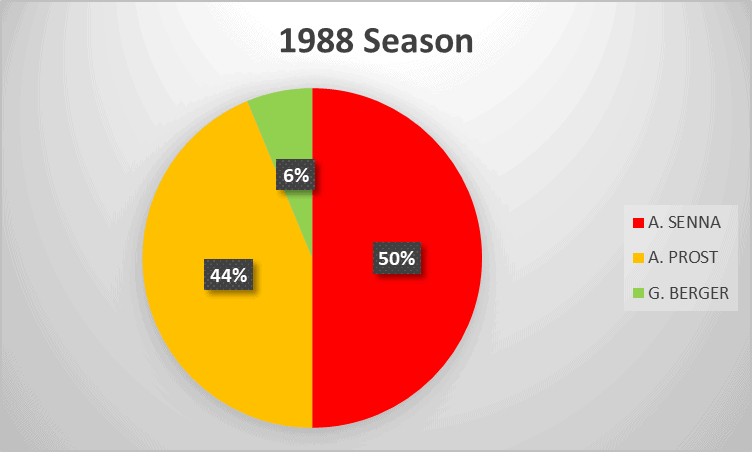
The 1989 Formula 1 season will always be remembered for the infamous coming together of 1988 champion Ayrton Senna and his teammate Alain Prost on lap 47 of the Japanese Grand Prix. As Senna tried to overtake Prost in the chicane, Prost closed the door, and the teammates skidded off the track and onto the escape road, where both engines stalled.
Prost couldn’t get his car going, but Senna received a push from the marshalls and returned to the track. The Brazilian came back to score a staggering race win, however, at the conclusion of the race he was disqualified for missing the chicane by FIA President Jean Marie Balestre in a move that Senna believed was part of an FIA conspiracy, believing Balestre favoured his French compatriot Prost, as the disqualification essentially handed Prost the 1989 Driver’s Championship.
The rest of the 1989 season almost serves as a footnote to the controversy surrounding the Japanese Grand Prix, however it should be remembered that after such a dominant 1988 season, McLaren certainly didn’t have it all their own way in 1989, as six different race winners throughout the season.
Even though he only won four of the 16 races held in 1989, compared to Senna’s six race wins, Prost’s consistency would see him hoist the championship trophy at the seasons end in Australia.
Nigel Mansell, in his first season with Ferrari, took two race wins, as did Thierry Boutson for Benetton.
Alessandro Nannini (Benetton) won the Japanese Grand Prix courtesy of the disqualification of Senna, while Mansell’s Ferrari teammate Gerhard Berger also took one win, the Portuguese Grand Prix.
1989 in Numbers
Alain Prost: Championship Points – 76, Race Wins – 4, Percentage of Race Wins – 25%
Ayrton Senna: Championship Points – 60, Race Wins – 6, Percentage of Race Wins – 36%
McLaren-Honda: Percentage of Race Wins – 62%
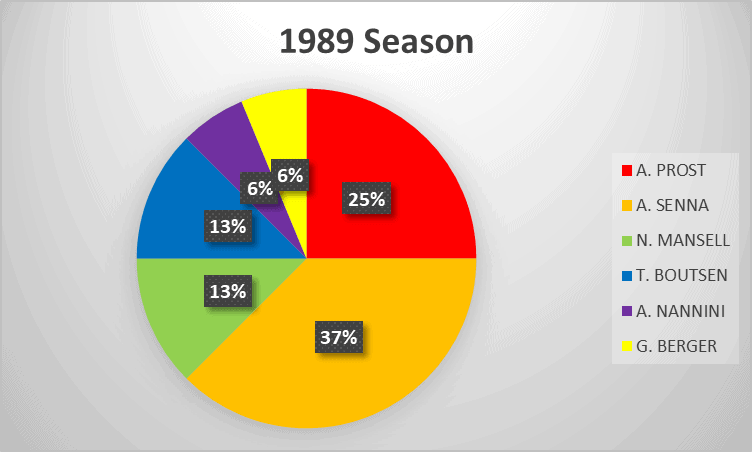
The tension caused by their 1989 title fight went up a notch in 1990, as Prost made the switch to Ferrari, and led the Scuderia’s first sustained run at a championship in a number of years.
The simmering feud between the former teammates would once again come to a head at Suzuka where Senna, furious that Prost was handed the clean side of the grid for the race start, had vowed to not let the Frenchman ‘make the corner’ should he lose the start.
Before the race Senna had gone to FIA President Jean Marie Balestre to request the sides be changed, however his request was denied.
As the race started, Prost got the jump on Senna, who led into the first corner. Prost was on the normal racing line, and Senna drove into him, his front left touching Prost’s rear wing, sending them both off the track, sealing the championship win for the Brazilian.
With Prost’s move to Ferrari for 1990, the season was the least dominant of the four consecutive Constructors Championships that McLaren would win between 1988 and 1991, as both Ferrari and McLaren won 38% of the races that year.
1990 in Numbers
Ayrton Senna: Championship Points – 78, Race Wins – 6, Percentage of Race Wins – 38%
Alain Prost: Championship Points – 71, Race Wins – 5, Percentage of Race Wins – 31%
McLaren-Honda: Percentage of Race Wins – 38%
Ferrari: Percentage of Race Wins – 38%

The 1991 Formula 1 season was a year of change in the sport, as Nigel Mansell returned home to Williams, Alain Prost was fired by Ferrari after a dispute towards the tail end of the season, three-time World Champion Nelson Piquet retired, and future champions Michael Schumacher and Mika Hakkinen made their debuts.
The season would also finish with Ayrton Senna’s third and final World Championship win.
Senna started 1991 in scintillating fashion, winning the first four Grand Prix in a row, before Nigel Mansell hit back, taking three consecutive wins including Magny-Cours, Silverstone, and Hockenheim.
Not only was Mansell pushing Senna all the way, his teammate Riccardo Patrese was also ensuring that Williams would take the fight with McLaren all the way to the final race of the season in Adelaide.
Unfortunately for Williams, torrential rain in the final race would see Mansell spin off and hit a wall, handing the Constructors Championship to McLaren for the fourth straight season.
1991 in Numbers
Ayrton Senna: Championship Points – 96, Race Wins – 7, Percentage of Race Wins – 44%
Nigel Mansell: Championship Points – 72, Race Wins – 5, Percentage of Race Wins – 31%
McLaren-Honda: Percentage of Race Wins – 50%
Williams: Percentage of Race Wins – 44%

McLaren’s Domination Ends
McLaren’s period of dominance was abruptly ended in 1992, thanks to the Mansell-led Williams outfit who would win the first five races of 1992, and stitch up the Driver’s Championship in August, with five races still remaining.
Senna took three wins, but it was clear the wheel had turned, and that Williams was now the driving force of the sport.
The Schumacher Years: 2000 to 2004
For five successive seasons, the prancing horses of Michael Schumacher and Rubens Barrichello were second to none, galloping away from the field most race weekends, delivering five consecutive Drivers Championships for Schumacher, as well as six straight Constructors Championships for the Scuderia, having also won the title in 1999, the year Mika Hakkinen won his second Drivers Championship.
Having joined Ferrari in 1996, Schumacher had gone close to winning the title, but had never been able to reach the summit. In 2000, after a titanic tussle with Mika Hakkinen and David Coulthard (McLaren), the German finally ended the 21 year wait for a Ferrari World Champion, ushering in a five year period of domination by winning nine out of 17 races (including the last four races of the season) on the calendar.
2000 in Numbers
Michael Schumacher: Championship Points – 108, Race Wins – 9, Percentage of Race Wins – 53%
Mika Hakkinen: Championship Points – 89, Race Wins – 4, Percentage of Race Wins – 24%
Ferrari: Percentage of Race Wins – 59%
McLaren-Honda: Percentage of Race Wins – 41%
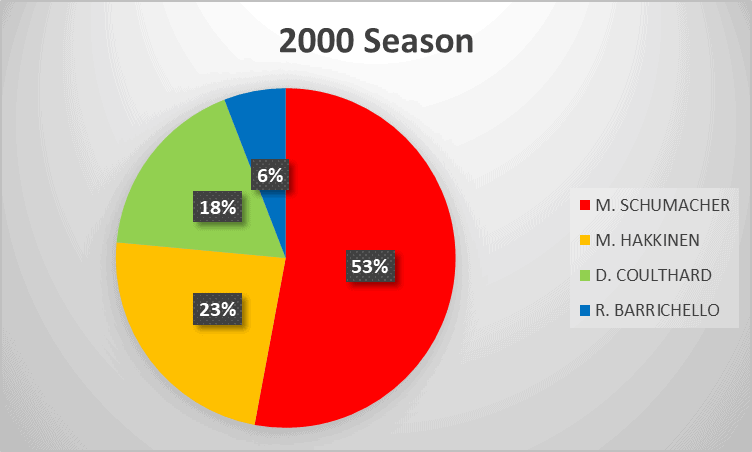
The 2001 Formula 1 season was something of a procession for Schumacher and Ferrari, as the reigning World Champion would take nine wins and five second places out of 17 races, to win the World Championship by a record 58 points.
Schumacher also set a new all-time record for Grand Prix victories, taking his 52nd career win at the 2001 Belgian Grand Prix.
Such was Schumacher’s domination of the 2001 season that he also recorded 11 pole positions during the season, turning six of those into race wins.
The end of the 2001 season would see the retirement of Schumacher’s closest rival Mika Hakkinen, veteran driver Jean Alesi, and longtime commentator Murray Walker.
2001 in Numbers
Michael Schumacher: Championship Points – 123, Race Wins – 9, Percentage of Race Wins – 53%
David Coulthard: Championship Points – 65, Race Wins – 2, Percentage of Race Wins – 12%
Ferrari: Percentage of Race Wins – 53%
McLaren-Honda: Percentage of Race Wins – 23%
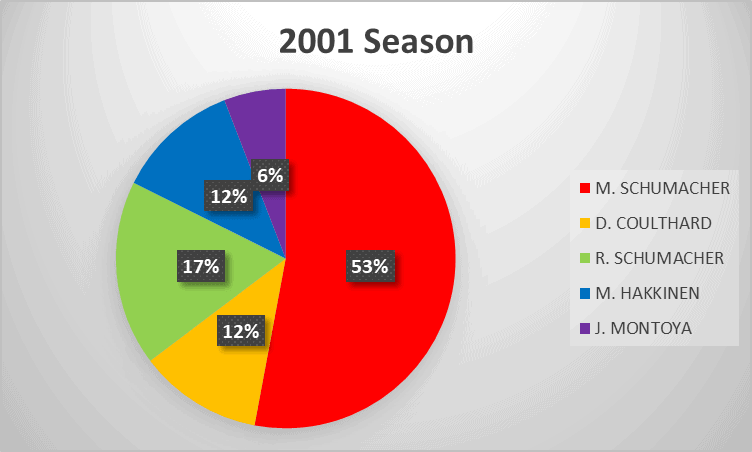
If the 2001 season was a procession for Schumacher, 2002 saw an even bigger display of dominance, as the German won a then-record 11 races for the season. He would finish first or second in every race, except Malaysia where he finished third, achieving a podium position in every race of the season.
The records continued to tumble in 2002, as Schumacher set a record for the shortest time needed to clinch the Driver’s Championship, winning the title at the French Grand Prix with six races remaining, and in the process winning by a then-record of 62 points over teammate Rubens Barrichello, beating his own previous record set in 2001.
Barrichello would win four out of the seventeen races, with Ralf Schumacher (Williams) and David Coulthard (McLaren) the only other drivers to take the top step throughout the season.
Such was the dominance of the Ferrari F2002 that with 144 Constructors Championship points, the Scuderia’s total would equal the combined sum of the points obtained by all other constructors for the season.
The FIA would then change the points system for the 2003 season.
2002 in Numbers
Michael Schumacher: Championship Points – 144, Race Wins – 11, Percentage of Race Wins – 65%
Rubens Barrichello: Championship Points – 77, Race Wins – 4, Percentage of Race Wins – 24%
Ferrari: Percentage of Race Wins – 88%
McLaren-Honda: Percentage of Race Wins – 6%
Williams: Percentage of Race Wins – 6%
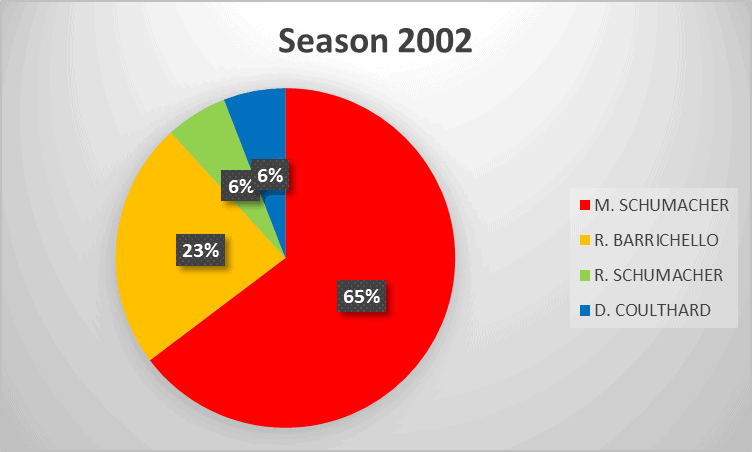
After having it all their own way for three straight years, the 2003 season saw the tightest finish of all the Schumacher championships in the 2000-2004 period, as Kimi Raikkonen in the McLaren and Juan Pablo Montoya in the Williams pushed Schumacher to the limit. There were a series of rule changes introduced in 2003 to increase excitement, such as one-lap qualifying, which had the desired effect as the championship battle went down to the wire.
With seven individual race winners in the 2003 Formula 1 season, consistency would be key, as evidenced by Kimi Raikkonen’s second place finish in the standings, just two points behind champion Schumacher, despite the Finn only winning one race.
Going into the final race of the season at Suzuka, with 10 points on offer Kimi Raikkonen could still win the title, while Schumacher only had to finish in eighth place or higher to secure his fourth consecutive Drivers Championship, and sixth overall.
Ferrari driver Rubens Barrichello started the race in Pole position, and would go on to win, ensuring Ferrari clinched their fifth Constructors Championship in a row, and their thirteenth overall. Barrichello’s race win and Schumacher’s eight place finish would also seal a record-breaking sixth Drivers Championship for Schumacher, who surpassed Juan Manuel Fangio.
2003 in Numbers
Michael Schumacher: Championship Points – 93, Race Wins – 6, Percentage of Race Wins – 38%
Kimi Raikkonen: Championship Points – 91, Race Wins – 1, Percentage of Race Wins – 6%
Juan Pablo Montoya: Championship Points – 82, Race Wins – 2, Percentage of Race Wins – 13%
Ferrari: Percentage of Race Wins – 50%
McLaren-Honda: Percentage of Race Wins – 13%
Williams: Percentage of Race Wins – 25%

After a tough fight in 2003, Schumacher would return to dominant form in 2004, taking out 13 of a possible 18 races. Schumacher’s teammate Rubens Barrichello added two wins, with Juan Pablo Montoya, Jarno Trulli, and Kimi Raikkonen taking one apiece.
Such was Schumacher’s dominance that he won 12 of the first 13 races of the season, and would go on to break his own record for most wins in a season, taking 13 victories overall.
In the Constructor’s Championship, Ferrari would secure their sixth straight title, however the season saw all ten teams score at least one World Championship point.
2004 in Numbers
Michael Schumacher: Championship Points – 148, Race Wins – 13, Percentage of Race Wins – 72%
Rubens Barrichello: Championship Points – 114, Race Wins – 2, Percentage of Race Wins – 11%
Ferrari: Percentage of Race Wins – 84%
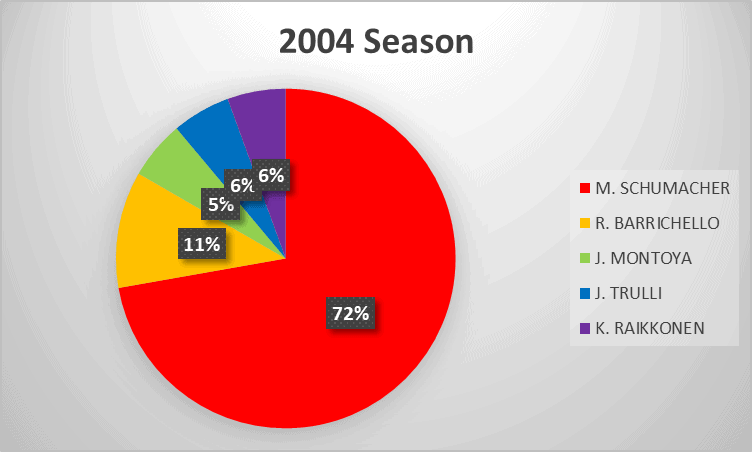
Schumacher’s Domination Ends
The 2005 Formula 1 season would see Schumacher and Ferrari’s dominant run come to an end as Spaniard Fernando Alonso took out his first championship for Renault, who also won the Constructor’s Championship in the same season.
Following a rule change that forbid tyre changes through the course of a race, Schumacher and Ferrari suffered with Bridgestone unable to find the right balance between performance and reliability, culminating in a third-place finish for both driver and constructor at seasons end.
Sebastian Vettel and Red Bull Racing: 2010 – 2014
The 2010 Formula 1 season was one of the tightest battles in living memory, as the season went down to the final race in Abu Dhabi, where four drivers could have won the championship; Red Bull Racing teammates Sebastian Vettel and Mark Webber, Fernando Alonso in the Ferrari, and Lewis Hamilton in a McLaren.
Vettel would take the race win, and the Drivers Championship, making him the youngest ever winner in Formula 1 history.
Such was the topsy-turvy nature of the 2010 championship that Sebastian Vettel, who had not led the championship at all throughout the season (in fact, there were a record 10 lead changes in the championship), would need to win the final race in Abu Dhabi and hope that championship leader Alonso finished lower than fourth.
Much like the season, the race was full of drama, as Alonso struggled for pace and lost ground thanks to his strategy of an early pit stop, which put him behind traffic and in seventh position on the road.
Unable to make up any positions, and with Vettel storming to victory, Alonso lost the championship to by four points, and a new era, the Vettel era, began.
Red Bull Racing also took out the Constructors Championship, their first, and after only six years racing in Formula 1.
2010 in Numbers
Sebastian Vettel: Championship Points – 256, Race Wins – 5, Percentage of Race Wins – 26%
Fernando Alonso: Championship Points – 252, Race Wins – 5, Percentage of Race Wins – 26%
Mark Webber: Championship Points – 242, Race Wins – 4, Percentage of Race Wins – 21%
Lewis Hamilton: Championship Points – 240, Race Wins – 3, Percentage of Race Wins – 16%
Red Bull Racing: Percentage of Race Wins – 46%
Ferrari: Percentage of Race Wins – 26%
McLaren: Percentage of Race Wins – 26%
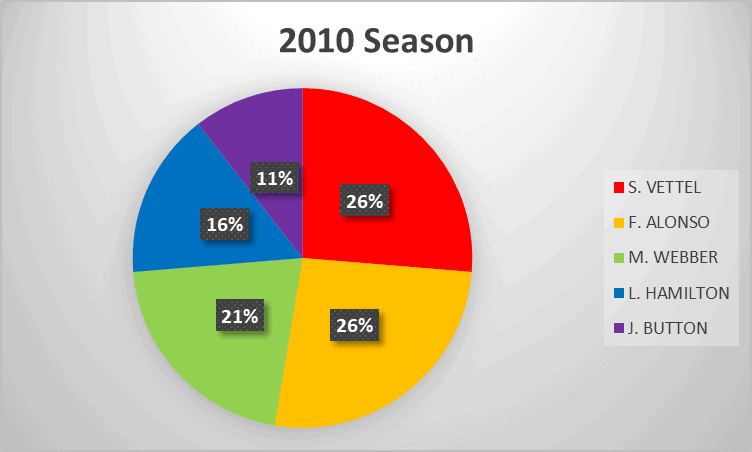
After sneaking home to win the 2010 title, Sebastian Vettel was dominant in 2011, defending his championship by winning 11 out of 19 races, and finishing on the podium in another five races. At just 24 years and 98 days, Vettel became the youngest driver to win two World Championships.
Jenson Button, who took three wins for McLaren, was a distant second, finishing a then-record 122 points behind the German ace.
2011 saw a very interesting rule return, the 107% rule for qualifying. Under this rule, any driver who failed to set a time within 107% of the fastest time in Q1 would not be permitted to enter the race, unless they could show just cause for inclusion, such as a mechanical issue during qualifying, but the driver had previously set a time within 107% during free practice.
In the opening race of the season in Australia, both Hispania F111 cars (driven by Narain Karthikeyan and Vitantonio Liuzzi both failed to qualify. It wouldn’t be the only time in 2011…
2011 in Numbers
Sebastian Vettel: Championship Points – 392, Race Wins – 11, Percentage of Race Wins – 56%
Jenson Button: Championship Points – 270, Race Wins – 3, Percentage of Race Wins – 16%
Red Bull Racing: Percentage of Race Wins – 63%
McLaren: Percentage of Race Wins – 32%
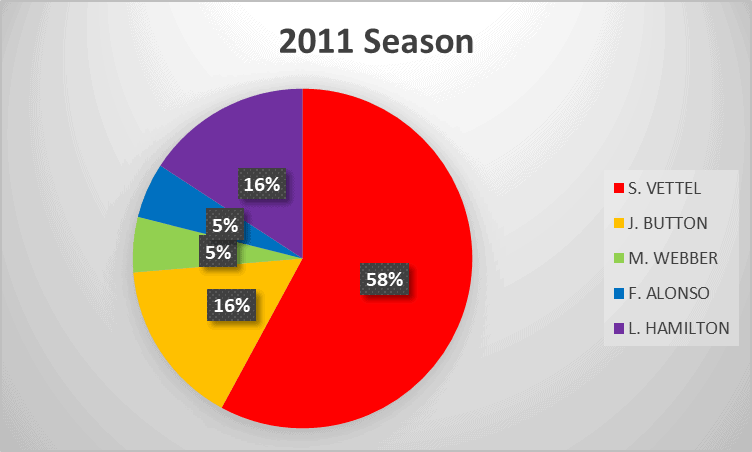
After cruising to the 2011 championship, Vettel didn’t have it all his own way in 2012, as seven different drivers won the first seven races of the season.
It wasn’t until Fernando Alonso won the European Grand Prix in June until a driver would make it two race wins. Alonso then hit a purple patch, winning in Germany and finishing on the podium in England, Italy, and Singapore, as the two-time World Champion looked to be taking a stranglehold on a third title.
Back to back DNFs, in Belgium and Japan, allowed Alonso’s competitors to capitalise, and it was Vettel who seized the opportunity, taking the lead of the Driver’s Championship after the Korean Grand Prix, with just four rounds remaining.
The battle would go down to the final race of the season, the 2012 Brazilian Grand Prix.
To win the title, Alonso would have to finish on the podium, and in a race that was too wet for slicks but not wet enough for wet tyres, there would be plenty of drama.
On the opening lap, Vettel was involved in an incident with Bruno Senna that saw the German suffer damage to his exhaust as well as a spin that would relegate him to the back of the field. As the rain continued to fall, the lead changed hands several times between Button, Hamilton, and Nico Hulkenberg.
As Hamilton and Hulkenberg jostled for the lead, Hulkenberg caused a crash that put Hamilton out of the race, and saw Hulkenberg given a penalty, which moved Alonso up to third position. Alonso the took second as his teammate Massa yielded the position, and with Vettel in twelfth, it looked like the Spaniard was set to win his third championship.
However, with 10 laps remaining, Vettel went on a charge. He sliced through the field, eventually moving up to sixth place, which was just enough to secure his third straight championship win.
2012 in Numbers
Sebastian Vettel: Championship Points – 281, Race Wins – 5, Percentage of Race Wins – 25%
Fernando Alonso: Championship Points – 278, Race Wins – 3, Percentage of Race Wins – 15%
Red Bull Racing: Percentage of Race Wins – 35%
McLaren: Percentage of Race Wins – 35%
Ferrari: Percentage of Race Wins – 15%

After a closely fought 2012 season, Sebastian Vettel and Red Bull Racing were back to their dominant best in 2013, with the three-time World Champion collecting 13 wins out of a possible 19 (tying the record Michael Schumacher set in 2004), which included a record run of nine consecutive victories between Round 11 in Belgium and the final round in Brazil.
2013 in Numbers
Sebastian Vettel: Championship Points – 397, Race Wins – 13, Percentage of Race Wins – 69%
Fernando Alonso: Championship Points – 242, Race Wins – 2, Percentage of Race Wins – 11%
Red Bull Racing: Percentage of Race Wins – 69%
Mercedes: Percentage of Race Wins – 16%
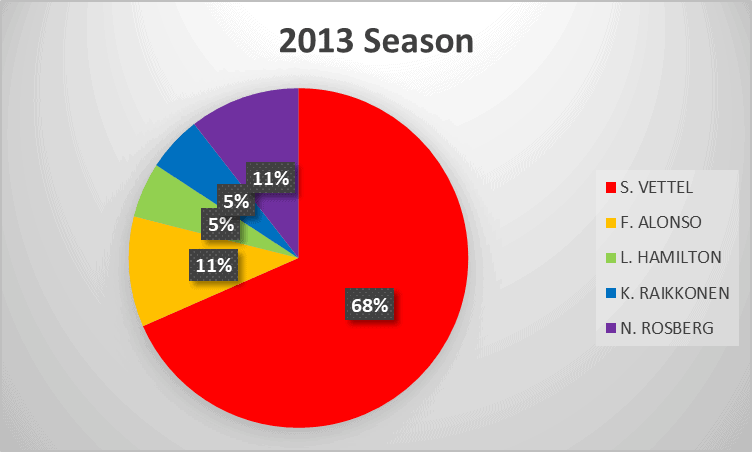
A Changing of the Guard?
Following his move from McLaren to Mercedes at the conclusion of the 2012 season, Lewis Hamilton had said he wanted the challenging of returning an iconic manufacturer to its former glories.
In a hint to what was to follow, in 2013 Nico Rosberg took Mercedes first win since returning to the sport, winning the Monaco Grand Prix, his first of two wins for the season, while Hamilton took his first win for Mercedes in Hungary.
With engines changing from a 2.4 litre V8 configuration in 2013 to a 1.6 litre turbo charged V6 engine in 2014, the scene was set for an epic showdown after such a massive shake up…
The Return of the Silver Arrows: 2014 to 2018
With four-time World Champion Sebastian Vettel aiming for a fifth straight championship to match his compatriot Michael Schumacher, the 2014 season was something of a non-event, such was the stranglehold the Silver Arrows of Mercedes took on the season.
Lewis Hamilton achieved what he set out to when he moved to Mercedes, delivering the German manufacturer a World Championship by taking 11 out of a possible 19 race wins, while his teammate would finish second in the standings after securing five race wins.
In his first season with Red Bull Racing, Australian Daniel Ricciardo won three races and finished third in the Championship. Surprisingly, defending champion Sebastian Vettel didn’t win a race, and slumped to fifth overall in the standings.
Not only did Mercedes go 1-2 in the Drivers Championship, they also won the Constructors Championship by a staggering 405 points after they scored 701 points, while second placed Red Bull Racing could only muster 296.
While most of the headlines of 2014 were written about Mercedes, the season will always be remembered for the death of Jules Bianchi after a crash at the Japanese Grand Prix. It was the first time since Ayrton Senna died in 1994 that a Formula 1 race saw an accident with fatal consequences, when Bianchi succumbed to his injuries on 17 July 2015 after being in a coma for nine months.
2014 in Numbers
Lewis Hamilton: Championship Points – 384, Race Wins – 11, Percentage of Race Wins – 58%
Nico Rosberg: Championship Points – 317, Race Wins – 5, Percentage of Race Wins – 26%
Mercedes: Percentage of Race Wins – 84%
Red Bull Racing: Percentage of Race Wins – 16%
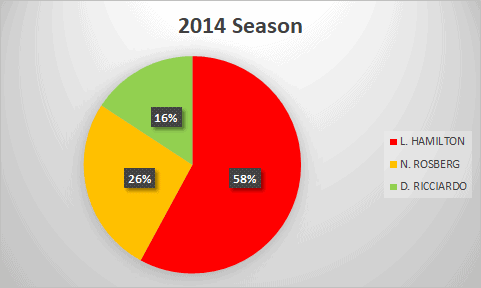
After moving from Red Bull Racing to Ferrari following the 2014 season, Sebastian Vettel and Ferrari were set to go head-to-head with Mercedes in a battle of two giants of the motoring industry in 2015.
In the end, the battle for supremacy would once again be between the two Mercedes drivers, with the rest of the field battling for third place.
Hamilton took 10 race wins to secure the third Drivers Championship of his career, while his teammate Rosberg won six races, again finishing runner up to the Brit.
In his first season with Ferrari, Vettel took three race wins to finish third overall in the Drivers’ Championship, helping the Scuderia to second in the Constructors Championship. Vettel’s win in Malaysia secured Ferrari’s first race win since the 2013 Spanish Grand Prix, and his first win since the 2013 Brazilian Grand Prix.
Interestingly, there were rumblings of discontent in the paddock as early as Round 1 of the season in Australia. Despite winning the Drivers and Constructors Championships for four years in a row between 2010 and 2013, Red Bull team adviser Helmut Marko was dissatisfied with the ease in which Mercedes were picking up titles, and hinted that the drinks maker could potentially exit Formula 1 if changes weren’t made to level the playing field or cut costs.
2015 in Numbers
Lewis Hamilton: Championship Points – 381, Race Wins – 10, Percentage of Race Wins – 53%
Nico Rosberg: Championship Points – 322, Race Wins – 6, Percentage of Race Wins – 32%
Mercedes: Percentage of Race Wins – 84%
Ferrari: Percentage of Race Wins – 16%
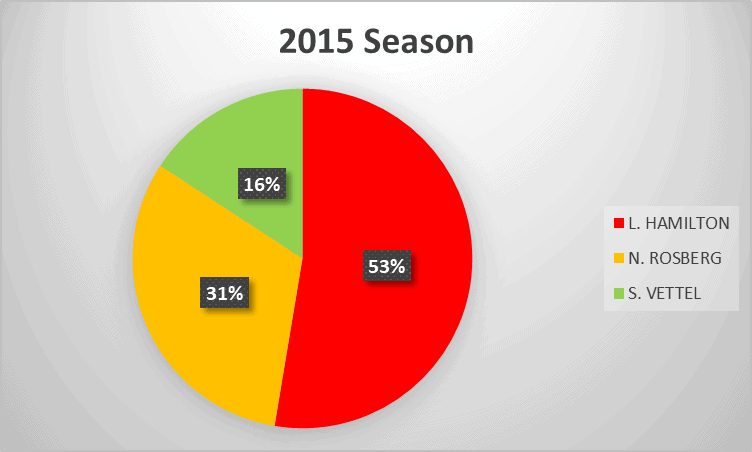
If their rivals were worried about Mercedes dominance in previous season, the worst was yet to come, as the Silver Arrows swept all before them in 2016, taking 19 wins out of a possible 21 in a show of absolute strength.
While the Constructors Championship was over almost before it began, the battle for the Drivers Championship would go down to the final race of the season as teammates Nico Rosberg and Lewis Hamilton did battle at the Yas Marina circuit in Abu Dhabi.
Going into the final race, Rosberg led Hamilton by 12 points, and had his maiden championship win in his grasp.
Hamilton took pole, then lead the race, with Rosberg second. Despite his team instructing him not too, Hamilton slowed the pace in an attempt to let Rosberg’s rivals overtake him.
In the end the tactic didn’t work, as Hamilton won and Rosberg finished second to clinch the title.
Five days later, Rosberg would announce his retirement from Formula 1, the first champion to do so since Alain Prost in 1993.
2016 in Numbers
Nico Rosberg: Championship Points – 385, Race Wins – 9, Percentage of Race Wins – 43%
Lewis Hamilton: Championship Points – 380, Race Wins – 10, Percentage of Race Wins – 48%
Mercedes: Percentage of Race Wins – 91%
Red Bull Racing: Percentage of Race Wins – 9%

Following Nico Rosberg’s retirement at the end of the 2016 season, Valtteri Bottas stepped into the second Mercedes and set about helping the German manufacturer to their fourth straight Constructors Championship, a goal they achieved at the 2017 United States Grand Prix, which was round 17 of 20.
In the race for the Drivers Championship, Mercedes had a fight on their hands, something they hadn’t experienced for a number of years.
A resurgent Vettel took the win I the opening round of the season, the 2017 Australian Grand Prix, and would go on to take a total of five race wins for the year.
The four-time champion actually led the championship battle for 12 rounds, all the way to Belgium, but consecutive race wins in Belgium, Italy, and Singapore saw Hamilton take the lead, never to be pegged back again.
With three rounds to go, at the 2017 Mexican Grand Prix, Hamilton would finish ninth, securing his fourth world title with two races remaining
2017 in Numbers
Lewis Hamilton: Championship Points – 363, Race Wins – 9, Percentage of Race Wins – 45%
Sebastian Vettel: Championship Points – 317, Race Wins – 5, Percentage of Race Wins – 25%
Mercedes: Percentage of Race Wins – 60%
Ferrari: Percentage of Race Wins – 25%
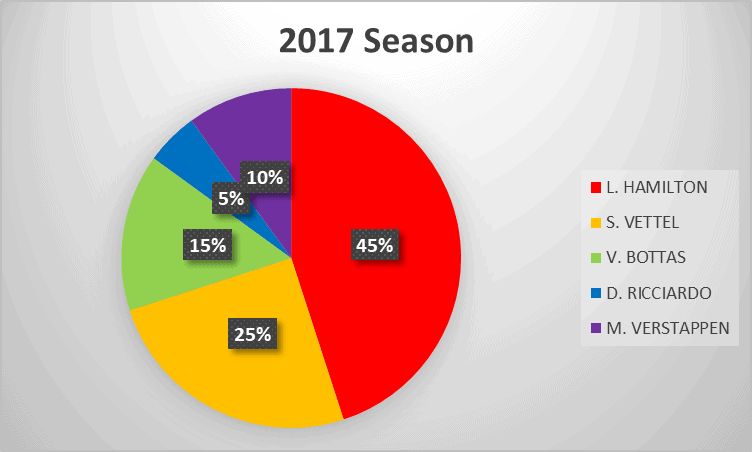
After giving Mercedes a scare in 2017, a hugely motivated Sebastian Vettel and Ferrari team flew out of the blocks, winning the opening two rounds in Australia and Bahrain.
Hamilton hit back, taking consecutive wins in rounds four and five in Azerbaijan and Spain, and the scene was set for a titanic tussle to the finish.
Chinks were starting to appear in the previously unflappable Vettel’s armour, and uncharacteristic errors started to creep into his driving, costing him points in the process.
Azerbaijan was the first race where the pressure started to show, as Vettel locked up on cold tyres following a safety car period, to drop out of the podium positions. A fifth-place finish in the 2018 French Grand Prix was the result of an opening lap crash with Valtteri Bottas, with the crash handing Hamilton the victory and the lead in the Drivers Championship.
Things seemed to be improving at his home race in Germany where Vettel took pole, and got off to a strong start in the race, however on lap 52, following a small rain shower, Vettel made an inexplicable error, driving off the track, into the barrier, and out of the race.
The mid-season break couldn’t come fast enough for the Ferrari driver…
The second half of the season started well for Vettel as he took the upper hand early, winning the 2018 Belgium Grand Prix with Hamilton in second place.
The two went blow for blow, but it was the 2018 Singapore Grand Prix that seemed to break the spirit of Vettel. At a track that Ferrari had traditionally been strong at, and one where Mercedes often struggled, Hamilton took pole position in a lap he described as ‘magical’ and one of the best laps of his career. Hamilton converted his pole into a race win, and also gained an air of invincibility.
As the battle resumed in Russia it was Hamilton who took another race win, thanks to team orders that were obeyed by Bottas, and it was then three in a row for the Brit after a win in Japan. The title was within touching distance.
After failing to win the title at the first attempt in the United States Grand Prix, Hamilton closed the door on Vettel, finish fourth, to secure his fifth Drivers Championship.
The Drivers Championship was settled, but the Constructors Championship was still up for grabs in the penultimate round of the season, the 2018 Brazilian Grand Prix.
Thanks to a moment of madness from Max Verstappen, who crashed with the Force India of Esteban Ocon who was trying to unlap himself, the race lead was handed to Hamilton, who duly obliged, taking his 10th win of the season. A fifth place for Bottas and a botched tyre strategy for Vettel saw Mercedes crowned Constructors Champions for the fifth successive season, a season in which they were pushed all the way by Ferrari.
2018 in Numbers
Lewis Hamilton: Championship Points – 408, Race Wins – 11, Percentage of Race Wins – 53%
Sebastian Vettel: Championship Points – 320, Race Wins – 5, Percentage of Race Wins – 24%
Mercedes: Percentage of Race Wins – 52%
Ferrari: Percentage of Race Wins – 29%
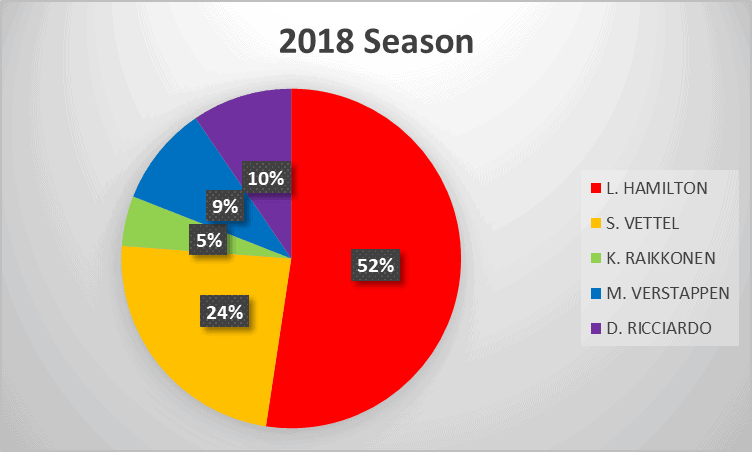
The 2019 Formula 1 season saw Mercedes launch a blitzkrieg in the opening rounds, winning the first eight grands prix in a row.
It wasn’t until Austria where Max Verstappen, at the Red Bull Racing home circuit, and in front of tens of thousands of Dutch supporters who had made the short trip to the Red Bull Ring, could break the Mercedes domination with a thrilling win.
After normal service was resumed with Hamilton winning the following round at Silverstone, Verstappen then one again, this time at the German Grand Prix, in what was a torrid day for Mercedes.
The mid-season break was a chance for teams to regroup, and Ferrari came flying out of the blocks, winning three races in a row. Charles Leclerc took back-to-back wins in Belgium and Italy, while his teammate Sebastian Vettel took his only win of the season in Singapore.
Mercedes then regained the ascendancy, winning four of the final five races to be crowned Constructor’s Champions for the sixth year in a row.
2019 in Numbers
Lewis Hamilton: Championship Points – 413, Race Wins – 11, Percentage of Race Wins – 52%
Valtteri Bottas: Championship Points – 326, Race Wins – 4, Percentage of Race Wins – 19
Max Verstappen: Championship Points – 278, Race Wins – 3, Percentage of Race Wins – 14
Charles Leclerc: Championship Points – 263, Race Wins – 2, Percentage of Race Wins – 9
Sebastian Vettel: Championship Points – 240, Race Wins – 1, Percentage of Race Wins – 4%
Mercedes: Percentage of Race Wins – 70%
Red Bull Racing: Percentage of Race Wins – 15%
Ferrari: Percentage of Race Wins – 15%
Is Formula 1 Boring? The Conclusion
Is Formula 1 boring?
No.
Does Formula 1 have periods of dominance?
Yes, it most certainly does.
As we saw in 1998, McLaren amassed a staggering 15 out of 16 race wins, and would have made it a clean-sweep if not for an engine failure for Prost at Monza.
In 2002 Michael Schumacher won 11 out of 17 races, and finished on the podium in the other six, while his teammate Rubens Barrichello added another four wins to give Ferrari a win percentage almost the same as Mercedes 2016 win percentage, and eclipsing Mercedes win percentage of 2014 and 2015.
Did any of the Tifosi complain that 2002, or any of The Schumacher Years, were boring?
No, they did not.
Formula 1 is a funny sport. When your team or driver are winning, it’s brilliant, when they are not, it’s ‘boring’.
It’s also very different to other sports, in that form plays less of a part. In sports such as basketball, baseball, football and so on, one moment, one win, can change the trajectory of a season. Formula 1 is more methodical, more precise, and that precision is often rewarded with trophies.
So how are we in this position where after every race weekend, people are lighting up Facebook groups and Reddit threads to complain about how boring Formula 1 is, and how the rules need to change so its more even, and how things were better in ‘my day’?
Simply put: access.
Today, nearly every person on the planet has access to a phone, an internet connection, and a social media platform.
Companies such as Facebook thrive on people sharing their opinions, and people can’t get onto these platforms fast enough to share every inane thought that passes through their head.
Compare this to the years McLaren dominated, when often the only way to find the results was to wait for the Monday newspaper.
If you wanted to complain about how boring their domination was, you would have needed to write a letter to the editor, find an envelope, buy a stamp, and put the letter in the mailbox.
It was never going to happen, not in the numbers we see today where giving your opinion is just a click away.
With qualifying sessions being won by hundredths of a second, more overtaking, and a midfield battle that swings wildly from week to week, we’re experiencing exciting races most weekends.
All sports will have their boring matches from time to time, and Formula 1 is no exception.
Does this mean we should change the rules to slow Mercedes, the current dominant team in Formula 1, down to the level of their competitors?
No, this isn’t primary school, in Formula 1 there’s no participation award just for trying your best.
And that’s the way it should be.
Still think Formula 1 is boring?
Well maybe my grandma was right about you…


